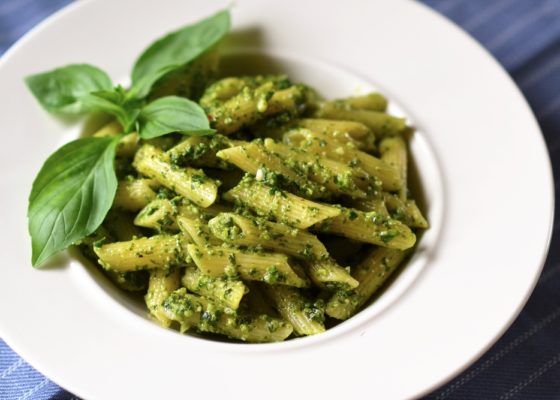
Fridge cleanout: easiest-ever pesto
Kale stems and spare greens step up to the plate for an impressive sauce that rivals the basil-only variety. This pesto recipe works with almost any green veggies you’ve got for a flavorful addition to pasta, sandwiches and snacks.
Ingredients:
- 2 cups greens, roughly chopped (try kale stalks, arugula, broccoli stems, spinach, radish greens, basil or a mix)
- ⅓ cup nuts such as pine nuts, walnuts or pecans
- Scant ½ cup grated Parmigiano Reggiano, Piave or similar malty hard cheese
- 3 cloves garlic, roughly chopped
- Juice and zest of 1 lemon
- ½ cup olive oil
- Morton Sea Salt, to taste
- Coarse ground pepper
Steps:
- In a food processor or blender, pulse first five ingredients including greens, nuts, grated cheese, garlic and lemon with zest, until just combined.
- Gradually add olive oil in 3 batches until pesto is smooth but not liquefied.
- Add sea salt and a few cranks of pepper. Blend one more time.
- Toss pesto with prepared pasta, spread onto sandwiches or serve as a dip. Store in the fridge for up to 1 week (stir before using) or up to 1 month in the freezer.
Tips for success: Pat greens dry with a towel or use a salad spinner before blending for optimal pesto texture.

Soup Stock from Scraps
Into the stockpot, out of the bin! Antioxidant-packed veggie scraps are the star in this hearty stock. Make the classic recipe your own with a basic blend of water, herbs and anything from carrot tops to shellfish shells.
Ingredients:
- 2 quarts water, plus more as needed
- Roughly chopped vegetables, like carrots, celery, onions, tomatoes, sweet potato peels, cabbage, mushrooms*
- Leftover chicken bones, shrimp shells, or corn cobs (optional, for richer and more robust texture)
- Bay leaves
- Herbs for bouquet garni** such as parsley and thyme
- Morton Sea Salt, to taste
- Ground black pepper, to taste
Steps:
- Add all ingredients to a stockpot and cover with water. Use enough liquid to submerge ingredients fully and adjust to desired strength (more water = lighter flavor; less = more condensed flavor).
- Bring to a boil over medium high heat, stirring occasionally.
- Reduce heat to medium low and let simmer for one hour or longer.
- Carefully strain the stock through a colander or sieve into a heatproof container. Discard non-liquid ingredients.
- Enjoy stock in stews, soups or to replace water while cooking grains.
Tips for success: *Avoid bitter ingredients such as arugula, radicchio or citrus.**To create a bouquet garni, which sounds way fancier than it is, bundle dried herb sprigs with some twine. Try thyme and parsley.

Winter Panzanella “Bread Salad”
Raise your hand if you think croutons are the best part of salad? Then, raise your glass to this 16th century Tuscan recipe that gets its signature crunch from none other than stale bread. It’s as delicious now as it was then.
Ingredients:
- 1 loaf stale bread, cubed*
- ½ cup seasonal fruit, such as pomegranate seeds, chopped apples, cooked butternut squash, or heirloom tomatoes**
- Olive oil, for coating bread
- Vinegar to taste
- Fresh or dried herbs such as basil and oregano
- 1 cup mixed greens
- Morton Sea Salt, to taste
- Coarsely ground pepper, to taste
Steps:
- Preheat oven to 350ºF or begin heating a skillet on medium low.
- Place fruit of choice in serving bowl and toss to coat with olive oil and vinegar (try red wine, cider vinegar or balsamic).
- In a separate bowl, toss bread cubes with herbs and generous drizzle of olive oil until evenly-coated. Transfer to large baking sheet or skillet. Toast bread in oven or on stovetop for about 10 minutes, flipping frequently with tongs. Remove from heat and let cool.
- Add toasted bread, fruit (optional) and salad greens to bowl with tomatoes. Season with salt and pepper to your liking.
- Let panzanella sit up to 30 minutes, allowing flavors to marinate. Serve the same day.
Tips for Success: *If bread is too hard to cut, soak in water until loosened or cover loaf and break into chunks with a hammer. **Making this another time of year? Choose in-season fruit whenever possible.
